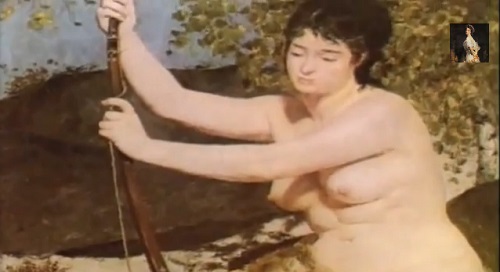(New York, June, 2023)—The Metropolitan Museum of Art announced today its upcoming summer and fall exhibitions along with new live arts performances and summer initiatives, including the return of the bike valet program, ongoing date night offerings, and more.
“The stories we tell at The Metropolitan Museum of Art are ever expanding,” said Max Hollein, Marina Kellen French Director of The Met. “Through groundbreaking exhibitions, compelling displays, and powerful performances and programs, this upcoming season is sure to delight, inspire, and engage audiences from near and far.”
Highlights of The Met’s summer exhibitions include: Grounded in Clay: The Spirit of Pueblo Pottery(opening July 14), a presentation of Pueblo Indian pottery and the first community-curated Native American exhibition in the history of The Met;Tree & Serpent: Early Buddhist Art in India, 200 BCE–400 CE (opening July 21), featuring never before publicly exhibited masterpieces that trace the aesthetic impact of the religion on Indian art; Art for the Millions: American Culture and Politics in the 1930s(opening September 7), surveying how artists searched for cultural identity during a decade of political and social upheaval in the United States; The Facade Commission: Nairy Baghramian, Scratching the Back(opening September 7), the fourth in a series of contemporary commissions for The Met’s facade and the artist’s first public installation in New York City; and Picasso: A Cubist Commission in Brooklyn (opening September 14), a focused exhibition dedicated to a captivating, but lesser-known chapter of the artist’s Cubist period. It will bring together for the first time six paintings linked to Picasso’s unrealized decorative commission for the Brooklyn residence of artist, collector, and critic Hamilton Easter Field (1873–1922).
Fall season highlights include: Manet/Degas (opening September 24), the first major exhibition examining one of the most significant artistic dialogues in the genesis of modern art; The Great Hall Commission: Jacolby Satterwhite, A Metta Prayer(opening October 2) an immersive multi-channel video installation and a series of performances that will transform the Museum’s iconic Great Hall; Vertigo of Color: Matisse, Derain, and the Origins of Fauvism (opening October 13), exploring how the artists manipulated and experimented with color to create a new artistic vocabulary; Proof: Maxime Du Camp’s Photographs of the Eastern Mediterranean (opening October 23), the first exhibition to focus on The Met’s rare collection of photographs made by Du Camp in advance of his landmark 1852 book, Egypte, Nubie, Palestine et Syrie; and Lineages: Korean Art at The Met (opening November 7), which will celebrate the 25th anniversary of the Museum’s Arts of Korea gallery with a collection of works tracing the history of Korean art.
Additionally, Africa & Byzantium (opening November 19), a major exhibition of nearly 200 works that explores the tradition of Byzantine art and culture in Africa from the 4th through the 15th century and beyond, will be presented at The Met Fifth Avenue through March 3, 2024, and feature many international loans being exhibited in the United States for the first time.
On November 20, 45 galleries dedicated to European Paintings, 1300–1800 will reopen, following the completion of an extensive skylights renovation project that began in 2018. The major reinstallation will highlight fresh narratives and dialogues among more than 700 works of art from the Museum’s world-famous holdings.
The 2023–24 season of MetLiveArts will include music, dance, and theatricalized culinary experiences that will invite deeper connections and make powerful observations about relevant cultural narratives as well as the Museum itself.
Upcoming public programs include Short Films for Short Nights, screenings of early video art accompanied by live music (July 7-9); the grand opening of the 81st Street Studio, a new children’s library and multipurpose active learning center (opening September 9); and the return of MetFest, the Museum’s community-wide block party (October 21).
The Museum also announced a continuing tradition of the summer season: the return of its popular bike valet program, which will be offered on Saturdays, Sundays, and select holidays through Labor Day (September 4). Guests visiting the Museum, regardless of transportation method, have the opportunity to experience The Met’s current blockbuster exhibition program, including Karl Lagerfeld: A Line of Beauty(through July 16), with extended viewing hours until 9 p.m. on Sundays, and Van Gogh’s Cypresses (through August 27).
Tag Archives: Manet
An Artist Life Means Putting Your Guts Out Into The World
The formula for a life well lived might look something like this: Dive in head first > fail > repeat.
Life is a series of cycles. There is of course the broad cycle, we are born, we live, we age, we die. But within this scope are countless other cycles for every part and parcel of our time on the planet. The cycle of making mistakes, of continually pouring your guts out to the world and enduring the consequences, is one of the most important there is for artists. From this process you learn the most about who you are, and how you fit in the world. There will be plenty of moments when you are a total mismatch, when you throw yourself into the deep end and struggle to stay afloat. Under no circumstances should these moments be viewed as set-backs or failure.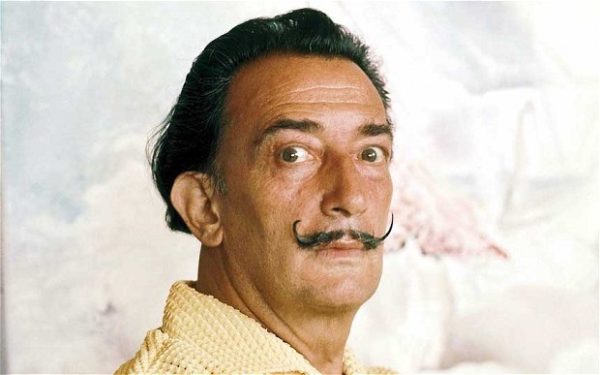
Salvador Dali once said, “Have no fear of perfection, you’ll never reach it.” Take a minute to consider that. Really let it sink in. Let your mind internalize this notion and let it unleash a wave of relief through your whole body. What fantastic news this is, no matter what you do, no matter how long you live, you, I, we, not one of us, will ever be perfect. So how can you take this beautiful knowledge and use it to your own advantage? Once you are free from the restraints of perfection, how can this inform the way you continue on your path?
By adopting the formula above and not letting go no matter what.
You probably know stories about how mistakes have changed history for the better over and over again. The accidental discovery of Penicillin because scientists noticed that the mold on some forgotten fruit killed bacteria. Or the invention of silly putty (perhaps not on par with life-saving antibiotics when it comes to historic moments, but a great boon to childhood all the same) quite by accident in a military lab as scientists tried to create an inexpensive substitute for rubber. But have you ever really stopped to consider what these stories mean to an artist? How they can be freeing examples of the importance of making mistakes?
There is likely not a person out there who truly believes that perfection is attainable, but we are told far too often that we ought to strive for it. This leads to untold restraint, dissatisfaction, and who knows how many missed opportunities for glorious screw ups. Do not let this trap take hold of you. Throw your best and worst, craziest and most tame ideas out there for all the world to see. Who cares if you land flat on your face, as long as you’re still able to pick yourself up there’s no harm done.
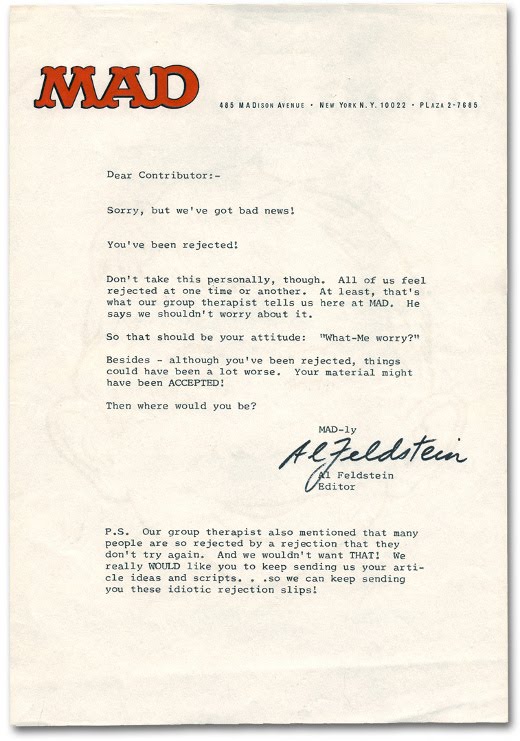 As an artist you will be the recipient of rejection letters and emails. Stacks of them. Count on it. In every creative field, there are piles and piles of rejections to be gone through. Walt Disney was once fired for what his editor deemed a lack of imagination. Countless famous artists throughout history were rejected in their lifetimes, some only achieving posthumous success. Van Gogh, Manet, Turner, they all have in common that they faced painful rejection in their lifetimes. They also have in common that they didn’t give up their unique perspective on the world nor did they allow something as insignificant as rejection stand in the way of their forward momentum.
As an artist you will be the recipient of rejection letters and emails. Stacks of them. Count on it. In every creative field, there are piles and piles of rejections to be gone through. Walt Disney was once fired for what his editor deemed a lack of imagination. Countless famous artists throughout history were rejected in their lifetimes, some only achieving posthumous success. Van Gogh, Manet, Turner, they all have in common that they faced painful rejection in their lifetimes. They also have in common that they didn’t give up their unique perspective on the world nor did they allow something as insignificant as rejection stand in the way of their forward momentum.
Collect your rejection letters. Create a special binder for them. Own them with pride knowing that you earned each and every one of them by putting a piece of yourself out into the world. Begin to think of rejection as a victory in itself because it means you tried. The moment you receive a rejection letter, consider that at that same moment, had you not tried, there would be nothing at all. Not trying isn’t really a way of avoiding rejection, it is simply a way of hiding from the world. You will never get anywhere at all if you don’t reveal yourself.

Artists are perhaps particularly vulnerable when it comes to the consequences of baring their souls to the world. Art is highly personal and the thought of making a mistake when the stakes are so intimately high can be enough to frighten even the boldest spirit. Rejection can feel like a very personal affront and can make it difficult to want to try again. It comes down to a choice really, to stay safe and make no progress, or let it all hang out and learn from every single mistake.
Just like with everything else in life, you will become accustomed to accepting rejection and mistakes as par for the course. There will come a day when you will leaf through your binder of rejection letters with a wisdom that can only be gained through the repeated process of failing. For the Silo, Brainard Carey.
Brainard is currently giving free webinars on how to write a better Artist bio and statement and how to get a show in a gallery – you can register for that live webinar and ask questions live by clicking here.
Heritage Auction Featured Renoir’s Personal Items
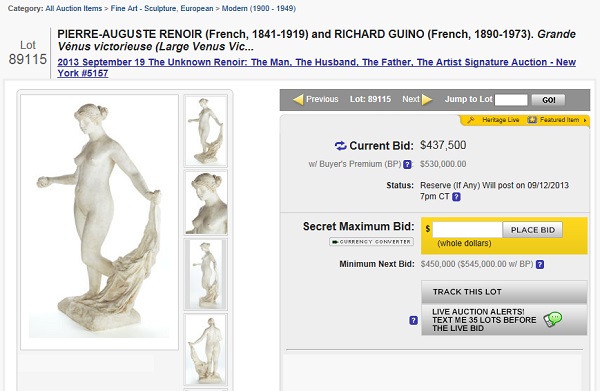
Grande Vénus victorieuse (Large Venus Victorious), 1914-15
Original plaster
71 inches (180.3 cm) high
Published by Vollard, Paris
THE RENOIR COLLECTION
With her weight rested on her right hip, holding a drape in her left hand and the golden apple in her right, this standing female nude is said to be the culmination of Renoir’s sculptural works. Transforming paradox into perfection, Renoir marries contradictory attributes to personify his idea of female quintessence. Vénus victorieuse the Woman is majestic yet simple, engaged and yet isolated, familiar but also obscure. With this sculpture, Renoir redefines classical theme and form to portray the eternal beauty of Woman – a leitmotiv apparent in much of his work.
LITERATURE:
P. Haesaerts, Renoir Sculptor, New York, 1947, p. 24, no. 6, illustrations of another cast pls. XIV-XXI.
NOTE:
This original foundry plaster is not copyright protected.
images :ha.com
The single largest archive of Pierre-Auguste Renoir’s personally-owned objects — from his signature polka-dot scarf to the original plaster maquette of La Grande Venus Victrix — will highlight an expansive grouping dedicated to the Impressionist icon in Heritage Auctions’ The Renoir Estate Collection Signature® Auction, Sept. 19 in New York.
The collection is an intimate glimpse inside the personal and professional life of the master painter through a trove of important documents, including his marriage certificate, photographs and letters written to Renoir from friends and contemporaries such as Monet, Manet, and Rodin. The collection also features a selection of original sculptural plaster maquettes created at Renoir’s estate in Cagnes, France, in the twilight of his career. Battling severe arthritis, Renoir collaborated with a young and able-handed artist, Richard Guino, at his dealer Ambroise Vollard’s suggestion.
Together, Renoir and Guino selected which drawings and paintings would work as sculptures, and they set to work. Included among the sculptural offerings is likely the auction’s top lot — a 72 inch tall original plaster maquette for La Grande Venus Victrix, the Roman goddess.
This museum-level collection is superb in its completeness and reveals volumes about the man and his art,” said Brian Roughton, Managing Director of Fine Art at Heritage Auctions. “It touches every corner of his life and represents the last time this collection will appear assembled ever again. In addition to the personal letters and objects, we’re also thrilled to have the opportunity to offer 20 carefully collected original plaster maquettes.”
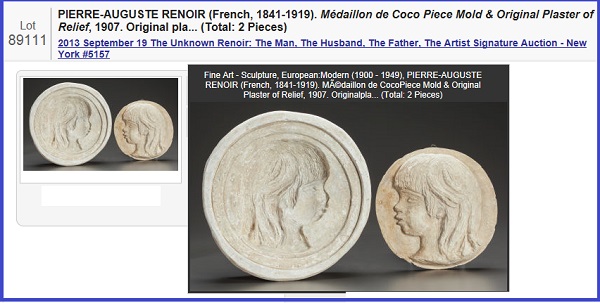
Médaillon de Coco Piece Mold & Original Plaster of Relief, 1907
Original plaster
8-1/2 inches (21.6 cm) (relief diameter)
11-1/2 inches (29.2 cm) (diameter with borders)
Published by Hodebert, Paris & Flechtheim, Berlin
THE RENOIR COLLECTION
Renoir’s first sculptural work, this medallion and the bust of his youngest son, Claude “Coco” Renoir are the only two sculptures Renoir executed entirely with his own hands. The work was intended to decorate the fireplace in the dining room of Les Collettes at Cagnes, where it was displayed once finished.
Estimate: $20,000 – $30,000. LITERATURE:
P. Haesaerts, Renoir Sculptor, New York, 1947, p. 19, no. 1, illustration of another cast pl. III.
Among the maquettes, Heritage is offering “Coco,” one of the only plaster maquettes that Renoir produced himself, depicting his young son Claude.
The staggering amount of life documents, awards and ephemera includes rarities such as an American Medal of Honor awarded to Renoir at the 1883 Foreign Exhibition and an album of candid family photographs featuring Henri Matisse among other notable artists of the day. The archive also includes rarely seen objects likely made for the artist’s eyes only, such as a diminutive polychrome ceramic vase and sugar bowl thrown and painted with his son, Jean, at Les Collettes as Jean recuperated from War injuries at Les Collettes.
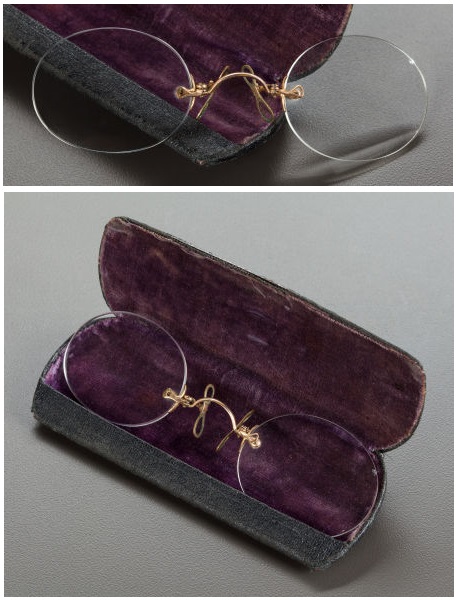
Artist Unknown:.
Condition Report*:
4.25 x 1.5 inches


